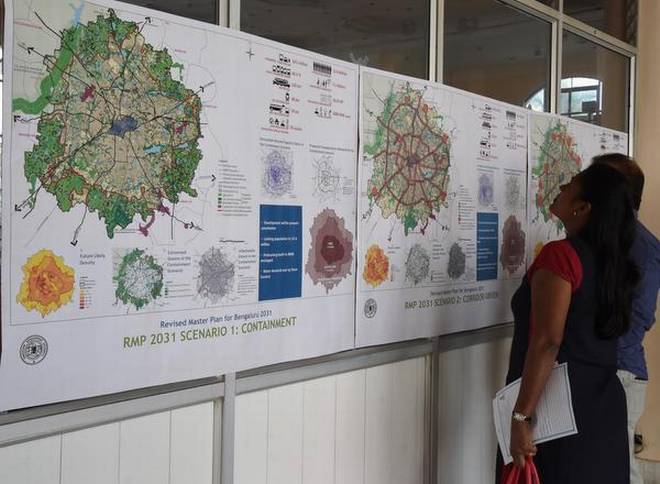
The Bangalore Development Authority published the Draft Revised Master Plan (RMP) -2031 in December 2017 and has invited comments from the public till January 23, 2018. We’ve commented elsewhere on the ‘differential strategy’ approach adopted in the plan. In this essay, we focus on institutional gaps in the planning process and plan implementation.
We show that foundational flaws in the democratic pedigree of institutions managing a weak consultative process has resulted in suboptimal outcomes in RMP-2031. It is now commonly understood that the BDA does not have the constitutional authority or the democratic legitimacy to plan for the city. The Constitution envisages planning by democratic bodies like the Municipal Corporation and the Metropolitan Planning Commission.
Nevertheless, the BDA has been conferred the statutory power to manage this process, and its constitutional authority to plan for Bengaluru is currently being challenged in the Karnataka High Court.
However, it is less commonly known that the BDA prepared RMP-2031 by outsourcing it to a private firm under a fixed time and cost contractual agreement. Arguably, private sector involvement is useful to bring in unavailable expertise, enhance efficiency and promote innovation. Despite planning being a core public function that is carried out every decade, the BDA had outsourced the function on the last occasion as well. This unnecessary layering of institutions and personnel inhibits local ownership of the plan, creates distance between those who prepare the plan and those who implement it.
It is unclear how this outsourcing arrangement has reduced costs or promoted innovation, but it is becoming clear how weak local ownership skews outcomes, and diminishes accountability. A democratic planning process would require the BDA and its consultants to undertake awareness building campaigns at the ward or neighbourhood level on the content of the RMP-2031. Though public consultation was held in each of the eight BBMP zones, it appears that public consultations with a few elite and strong Residents’ Welfare Associations in planned residential areas, such as Indiranagar and Koramangala, and relatively well-established professional associations has shaped the city’s future spatial development priorities.
As a result, the Draft RMP-2031 Zonal Regulations limit Floor Area Ratio in the core and increases it in the periphery to promote rapid development of the periphery resulting in undesirable urban sprawl. Further, Bengaluru’s urban fabric is very diverse. However, zonal regulations bluntly use road width and plot size to determine permissible FAR, and will damage the diversity of urban places in the city.
These traditional localities were less able to shape planning priorities and their concerns find little space in the Draft RMP 2031. Paying adequate attention to the diverse urban fabric of Bengaluru requires a sense of local history and economy as well as an ability to engage with diverse social groups.
BDA estranged from the city
A statutory agency like the BDA is itself estranged from the city. The outsourced contractor who prepares the plan has no incentive, either commercial or legal, to engage with the city in a comprehensive manner. Hence, complex political challenges are resolved merely with cartographic manipulations.
Even the best made plans for the city would require an effective enforcement framework. Every resident of the city understands that Bengaluru’s existing model of plan enforcement is ineffectual. The chapter on ‘Implementation and Financial Framework’ is one of the shortest in the Master Plan Document and is sketchy about enforcement. It half-heartedly proposes a new Spatial Data Management Cell as the answer to effective plan implementation.
The BDA is designated the data custodian and is meant to work with BBMP to trace all planning permits. An integrated data portal requires an environment of data sharing and openness with all organisations of the city for continuous data creation and updating, which the plan must address.
The RMP-2031 also proposes a new ‘Master Plan Coordination and Monitoring Committee’ for implementing the plan. This committee does not have a legally sound foundation and is unlikely to make any meaningful impact on plan implementation. Planners and citizens alike have demanded a bottom-up plan formulation and implementation process as a prerequisite for effective plan enforcement.
In the series on planning for Bengaluru, published in The Hindu in February-March 2017, we argued for the urgent need to shift from a supply led planning process to one that acknowledges real demand on the ground, and advanced a negotiated plan implementation process at the parcel level for locally responsive development. Moreover, several committees appointed by the government of Karnataka have identified enforceability of the plan as a core problem and suggested new institutional solutions.
The BBMP Restructuring Committee 2017 has proposed a three-tier governance structure for Bengaluru with clear roles for democratic bodies like the Ward Committees, multiple Municipal Corporations and a Greater Bengaluru Authority in plan implementation. So, it is surprising that the RMP avoids any serious engagement with the institutional and governance framework to implement the plan.
The Draft RMP-2031 is yet to respond to the complex urban fabric of Bengaluru, and overcome the institutional deficits inherent in the planning and implementation process. Unless the BDA and their consultants invest significantly more attention to the implementation framework at this stage, RMP 2031 is likely to remain dead on arrival.
This article was originally published in The Hindu, on January 10th, 2018.
